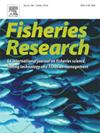Fishery biology of the Crevalle jack Caranx hippos (L) from the Colombian Caribbean
IF 2.2
2区 农林科学
Q2 FISHERIES
引用次数: 0
Abstract
The crevalle jack Caranx hippos is a significant fishery resource in the Caribbean Sea; however, biological information necessary for its effective management is currently lacking. To address this gap, this study conducted an integrated multiannual analysis of fishery-dependent data on the size structure, maturity, and spatiotemporal dynamics of landings in six Colombian Caribbean regions. This study found that encircling gillnets, drift gillnets, and seine nets yielded a higher catch in terms of mass, whereas handlines, encircling gillnets, and fixed gillnets captured small and immature specimens. These practices, which affect both adult and immature populations, appear to pose a significant threat to stock health, highlighting the need for preventive approaches to fishery management in Colombian waters. Additionally, the results revealed sexual dimorphism, with females being smaller than males, and the size at maturity of females was estimated at 54.2 cm LT (81 % immature and 19 % mature). Furthermore, this study recorded annual fluctuations in the number of landed specimens at all sites, with La Guajira in the northeastern area of the Colombian Caribbean and Atlántico in the southwest area showing the highest values. The findings suggest a decrease in the size at maturity of C. hippos over a span of ten years, with an average reduction of 2.25 cm LT per year, in response to fishing pressure. In addition, spatiotemporal factors that affect fleet operations play a key role in these fluctuations. This study emphasises the need to adopt comprehensive approaches to improve our understanding of the reproductive dynamics of crevalle jack stocks to ensure the sustainability of artisanal fishing.
哥伦比亚加勒比海Crevalle jack Caranx河马(左)的渔业生物学
绉鯵是加勒比海的重要渔业资源,但目前缺乏对其进行有效管理所需的生物信息。为了弥补这一空白,本研究对哥伦比亚加勒比海六个地区的尺寸结构、成熟度和上岸量的时空动态等渔业相关数据进行了综合多年度分析。该研究发现,环绕刺网、流刺网和围网的捕获量更大,而手绳、环绕刺网和定置刺网捕获的是小型和未成熟标本。这些做法既影响成年种群,也影响未成年种群,似乎对种群健康构成重大威胁,突出表明哥伦比亚水域渔业管理需要采取预防性方法。此外,研究结果还发现了性二型现象,雌性比雄性小,据估计,雌性成熟时的体长为 54.2 厘米(81%未成熟,19%成熟)。此外,这项研究还记录了所有地点上岸标本数量的年度波动,其中哥伦比亚加勒比海东北部地区的拉瓜希拉和西南部地区的阿特兰蒂科的上岸标本数量最高。研究结果表明,在十年的时间里,河马的成熟体型有所减小,平均每年减小 2.25 厘米(LT),这是对捕捞压力的反应。此外,影响船队作业的时空因素在这些波动中起到了关键作用。这项研究强调,有必要采取综合方法来提高我们对绉绸鰺种群繁殖动态的认识,以确保个体渔业的可持续性。
本文章由计算机程序翻译,如有差异,请以英文原文为准。
求助全文
约1分钟内获得全文
求助全文
来源期刊

Fisheries Research
农林科学-渔业
CiteScore
4.50
自引率
16.70%
发文量
294
审稿时长
15 weeks
期刊介绍:
This journal provides an international forum for the publication of papers in the areas of fisheries science, fishing technology, fisheries management and relevant socio-economics. The scope covers fisheries in salt, brackish and freshwater systems, and all aspects of associated ecology, environmental aspects of fisheries, and economics. Both theoretical and practical papers are acceptable, including laboratory and field experimental studies relevant to fisheries. Papers on the conservation of exploitable living resources are welcome. Review and Viewpoint articles are also published. As the specified areas inevitably impinge on and interrelate with each other, the approach of the journal is multidisciplinary, and authors are encouraged to emphasise the relevance of their own work to that of other disciplines. The journal is intended for fisheries scientists, biological oceanographers, gear technologists, economists, managers, administrators, policy makers and legislators.
 求助内容:
求助内容: 应助结果提醒方式:
应助结果提醒方式:


